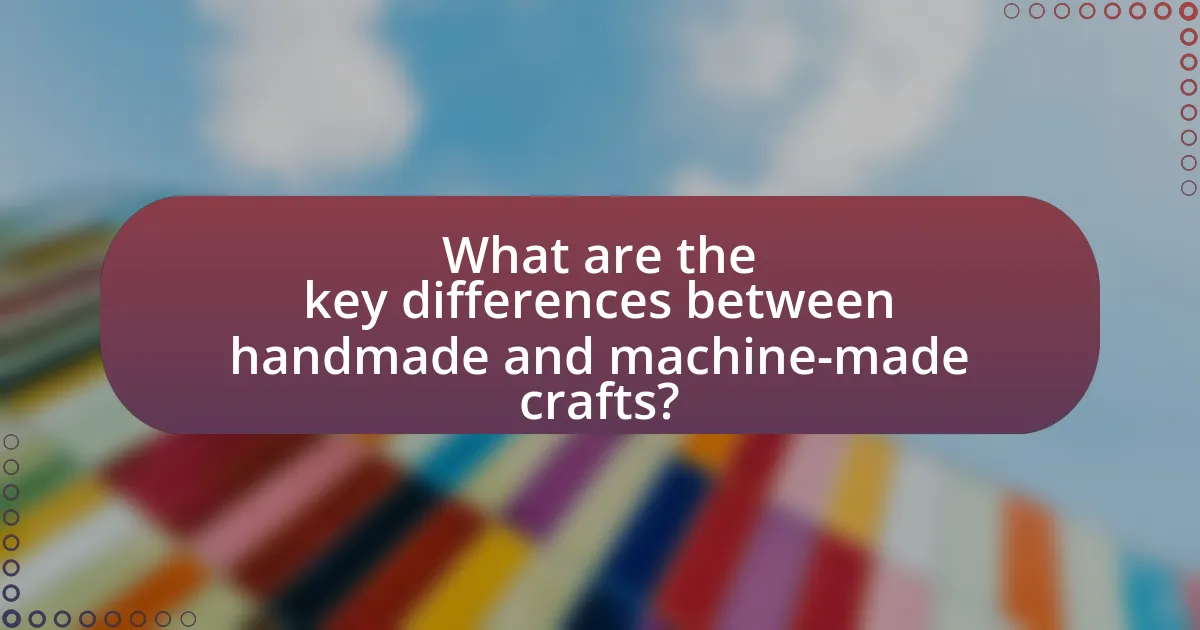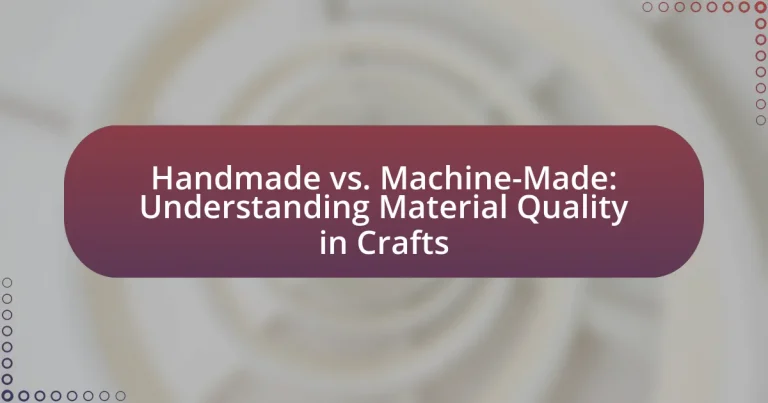The article examines the key differences between handmade and machine-made crafts, focusing on material quality and production processes. Handmade crafts are characterized by individual craftsmanship, unique designs, and the use of high-quality materials, while machine-made crafts prioritize efficiency, uniformity, and lower production costs. The discussion includes the impact of these differences on durability, consumer perception, and environmental implications, as well as the advantages and disadvantages of each type of craft. Additionally, the article highlights the challenges artisans face in the handmade market and offers practical tips for consumers when choosing between handmade and machine-made items.

What are the key differences between handmade and machine-made crafts?
Handmade crafts are created by artisans using manual techniques, while machine-made crafts are produced using automated processes and machinery. The key differences include the level of personalization and uniqueness; handmade items often exhibit individual characteristics and imperfections that reflect the artisan’s skill, whereas machine-made items are uniform and consistent in quality due to mass production. Additionally, handmade crafts typically use higher-quality materials, as artisans often select materials based on their aesthetic and functional properties, while machine-made crafts may utilize lower-cost materials to maximize production efficiency. This distinction in material quality and production method influences the overall value and appeal of the crafts.
How does the production process differ between handmade and machine-made items?
The production process of handmade items involves individual craftsmanship, where artisans create each piece manually, often using traditional techniques and tools. In contrast, machine-made items are produced through automated processes, utilizing machinery that can replicate designs at a faster rate and with greater uniformity. Handmade production typically allows for unique variations and personal touches, while machine-made production emphasizes efficiency and consistency, often resulting in lower costs and higher output. This distinction is evident in industries such as textiles, where handmade fabrics may feature intricate patterns that reflect the artisan’s skill, whereas machine-made fabrics are produced in bulk with standardized designs.
What techniques are used in handmade crafting?
Handmade crafting employs various techniques, including knitting, sewing, weaving, pottery, and woodworking. Each technique utilizes specific tools and methods to create unique, artisanal products. For instance, knitting involves interlocking yarn with needles to form fabric, while sewing combines pieces of fabric using a needle and thread to create garments or other items. Weaving uses a loom to interlace threads, pottery involves shaping clay and firing it in a kiln, and woodworking entails cutting and assembling wood to create furniture or decorative pieces. These techniques highlight the skill and creativity involved in handmade crafting, distinguishing it from machine-made products.
What technologies are involved in machine-made production?
Machine-made production involves technologies such as computer numerical control (CNC) machining, robotics, 3D printing, and automated assembly lines. CNC machining utilizes computer programming to control machine tools for precise cutting and shaping of materials, enhancing efficiency and accuracy. Robotics in manufacturing automates repetitive tasks, increasing production speed and reducing human error. 3D printing allows for the rapid prototyping and production of complex designs directly from digital models, facilitating customization. Automated assembly lines streamline the manufacturing process by integrating various machines and systems to work in unison, significantly boosting output. These technologies collectively contribute to the scalability and consistency of machine-made products compared to handmade alternatives.
What impact do these differences have on material quality?
Differences between handmade and machine-made processes significantly impact material quality. Handmade items often exhibit superior craftsmanship, as artisans can select high-quality materials and apply techniques that enhance durability and aesthetics. For instance, a study by the Crafts Council found that handmade textiles often use natural fibers, which contribute to better breathability and longevity compared to synthetic fibers commonly used in machine-made products. Additionally, handmade goods typically undergo more rigorous quality control, as each piece is individually inspected, leading to fewer defects and a higher overall standard of quality. In contrast, machine-made items may prioritize efficiency and cost-effectiveness, often resulting in lower-quality materials and less attention to detail, which can compromise the final product’s integrity.
How does craftsmanship influence the durability of handmade items?
Craftsmanship significantly influences the durability of handmade items by ensuring meticulous attention to detail and the use of high-quality materials. Skilled artisans apply techniques honed over years, which often involve traditional methods that enhance structural integrity and longevity. For example, handmade furniture typically features joinery techniques like dovetailing, which provide greater strength compared to mass-produced alternatives. Additionally, artisans often select superior materials, such as hardwoods or natural fibers, which are more resilient than synthetic options commonly used in machine-made products. This combination of expert craftsmanship and quality materials results in handmade items that can withstand wear and tear over time, often lasting generations.
What role does precision play in the quality of machine-made products?
Precision is crucial in determining the quality of machine-made products, as it directly influences their consistency, functionality, and overall performance. High precision in manufacturing processes ensures that each product meets exact specifications, which minimizes defects and variations. For instance, in the automotive industry, components produced with a precision of ±0.01 mm can significantly enhance the reliability and safety of vehicles, as even minor deviations can lead to malfunctions. This level of accuracy is often achieved through advanced technologies such as CNC machining and laser cutting, which are designed to maintain tight tolerances. Therefore, precision not only enhances the aesthetic appeal of machine-made products but also ensures their durability and effectiveness in practical applications.

Why is material quality important in crafts?
Material quality is crucial in crafts because it directly influences the durability, aesthetics, and functionality of the final product. High-quality materials ensure that crafted items can withstand wear and tear, maintain their appearance over time, and perform their intended functions effectively. For instance, using premium wood in furniture making results in stronger, longer-lasting pieces compared to inferior alternatives. Additionally, studies have shown that consumers are willing to pay more for handcrafted items made from high-quality materials, reflecting the perceived value and craftsmanship associated with such products. This correlation between material quality and consumer satisfaction underscores its importance in the crafting process.
How does material quality affect the overall value of a craft?
Material quality significantly influences the overall value of a craft by determining its durability, aesthetic appeal, and market demand. High-quality materials enhance the longevity and functionality of crafted items, making them more desirable to consumers. For instance, a study published in the Journal of Consumer Research indicates that products made from premium materials are perceived as more valuable, leading to higher price points and increased consumer willingness to pay. Additionally, the use of superior materials often reflects the skill and craftsmanship involved, further elevating the item’s status in the market.
What are the characteristics of high-quality materials?
High-quality materials possess durability, consistency, and aesthetic appeal. Durability ensures that the materials withstand wear and tear over time, which is essential for longevity in crafts. Consistency refers to uniformity in texture, color, and performance, allowing for reliable results in handmade or machine-made products. Aesthetic appeal involves the visual and tactile qualities that enhance the overall experience of the crafted item. For instance, natural fibers like silk or wool are often considered high-quality due to their strength and luxurious feel, while synthetic materials may lack these characteristics.
How do consumers perceive the value of handmade versus machine-made items?
Consumers generally perceive handmade items as having higher value compared to machine-made items due to their uniqueness, craftsmanship, and emotional connection. Research indicates that 70% of consumers are willing to pay more for handmade products, valuing the personal touch and story behind each piece. This perception is reinforced by studies showing that handmade items are often associated with superior quality and authenticity, as they are crafted with care and attention to detail, unlike mass-produced machine-made items that prioritize efficiency over individuality.
What are the environmental implications of material choices in crafts?
Material choices in crafts significantly impact the environment through resource consumption, waste generation, and pollution. For instance, natural materials like wood and cotton can be sustainably sourced, reducing ecological footprints, while synthetic materials such as plastics contribute to pollution and are often derived from non-renewable resources. According to a study by the Ellen MacArthur Foundation, the production of synthetic fibers accounts for 35% of microplastic pollution in oceans, highlighting the detrimental effects of certain material choices. Additionally, the lifecycle of materials, including their biodegradability and recyclability, plays a crucial role in determining their overall environmental impact. Therefore, selecting eco-friendly materials can mitigate negative environmental effects associated with crafting.
How do sustainable materials impact the crafting process?
Sustainable materials significantly enhance the crafting process by promoting environmental responsibility and improving the quality of the final product. When artisans use sustainable materials, such as organic cotton or reclaimed wood, they reduce the ecological footprint associated with production, which aligns with growing consumer demand for eco-friendly products. Additionally, sustainable materials often possess unique characteristics, such as durability and natural aesthetics, which can elevate the craftsmanship and appeal of handmade items. For instance, a study published in the Journal of Cleaner Production highlights that using sustainable materials can lead to a 30% reduction in carbon emissions during the crafting process, demonstrating their positive impact on both the environment and product quality.
What are the ecological benefits of choosing handmade crafts?
Choosing handmade crafts offers significant ecological benefits, primarily through reduced environmental impact and sustainable practices. Handmade items typically utilize locally sourced materials, which minimizes transportation emissions and supports local economies. Additionally, the production of handmade crafts often involves fewer chemicals and less energy consumption compared to mass-produced items, leading to lower pollution levels. For instance, a study by the American Craft Council highlights that handmade goods can reduce carbon footprints by up to 50% due to their localized production processes. Furthermore, handmade crafts often emphasize the use of natural, biodegradable materials, which contribute to less waste in landfills and promote a circular economy.

What are the advantages and disadvantages of handmade and machine-made crafts?
Handmade crafts offer the advantage of uniqueness and personal touch, while machine-made crafts provide consistency and efficiency. Handmade items are often valued for their individuality, as each piece is crafted with care, reflecting the artisan’s skill and creativity. This uniqueness can lead to higher prices and a stronger emotional connection for buyers. Conversely, machine-made crafts benefit from uniformity and lower production costs, allowing for mass production and accessibility to a broader audience. However, the lack of individuality in machine-made items can result in lower perceived value among consumers who prioritize craftsmanship. Thus, the choice between handmade and machine-made crafts often hinges on the balance between personal connection and practicality.
What are the benefits of choosing handmade crafts?
Choosing handmade crafts offers several benefits, including uniqueness, quality, and support for local artisans. Handmade items are often one-of-a-kind, ensuring that consumers receive products that are distinct and not mass-produced. The quality of handmade crafts typically surpasses that of machine-made items, as artisans often use superior materials and take greater care in their craftsmanship. Furthermore, purchasing handmade crafts supports local economies and small businesses, fostering community growth and sustainability. According to a study by the Craft Industry Alliance, 70% of consumers prefer handmade products due to their perceived quality and the personal touch involved in their creation.
How does supporting handmade crafts contribute to local economies?
Supporting handmade crafts significantly contributes to local economies by fostering job creation and retaining financial resources within communities. When consumers purchase handmade goods, they directly support local artisans, which helps sustain small businesses and encourages entrepreneurship. According to a report by the Craft Industry Alliance, the craft sector generates approximately $44 billion annually in the United States, highlighting its economic impact. Additionally, handmade crafts often utilize locally sourced materials, further stimulating local suppliers and reducing transportation costs. This cycle of local spending enhances community resilience and promotes economic diversity, ultimately leading to a more robust local economy.
What unique qualities do handmade items offer to consumers?
Handmade items offer consumers distinct qualities such as uniqueness, craftsmanship, and emotional connection. Each handmade product is typically one-of-a-kind, reflecting the individual artisan’s style and creativity, which contrasts with mass-produced items that lack personal touch. The craftsmanship involved in creating handmade goods often results in superior quality, as artisans pay close attention to detail and use traditional techniques, leading to durability and aesthetic appeal. Furthermore, consumers often feel a stronger emotional connection to handmade items, as they represent the time, effort, and skill invested by the maker, fostering a sense of authenticity and support for local economies. This combination of uniqueness, quality, and emotional resonance makes handmade items particularly appealing to consumers seeking more than just a product.
What are the drawbacks of handmade crafts compared to machine-made items?
Handmade crafts often lack the consistency and precision found in machine-made items. Machine-made products benefit from advanced technology that ensures uniformity in size, shape, and quality, which is difficult to achieve with handmade techniques. For instance, a study by the National Institute of Standards and Technology highlights that machine manufacturing can produce items with tolerances as tight as 0.001 inches, while handmade crafts typically have greater variability due to human factors. Additionally, machine-made items can be produced at a faster rate, leading to lower costs and higher availability in the market. This efficiency can make handmade crafts less competitive in terms of pricing and accessibility.
How do cost and accessibility differ between handmade and machine-made products?
Handmade products typically have higher costs and lower accessibility compared to machine-made products. The higher costs of handmade items arise from the labor-intensive processes, unique craftsmanship, and often the use of premium materials, which can lead to prices that are significantly above mass-produced alternatives. For instance, a handmade ceramic mug may cost $30, while a machine-made equivalent could be priced at $5 due to economies of scale in production. Accessibility is also affected, as handmade products are often available through limited channels such as local markets or artisan shops, whereas machine-made products are widely available in retail stores and online platforms, making them easier to obtain for consumers.
What challenges do artisans face in the handmade market?
Artisans face several challenges in the handmade market, including competition from mass-produced goods, pricing pressures, and limited access to distribution channels. The prevalence of cheaper, machine-made products often undermines the perceived value of handmade items, making it difficult for artisans to compete on price. Additionally, artisans frequently struggle to find effective platforms to showcase and sell their work, as many traditional retail spaces favor larger brands. According to a report by the Craft Industry Alliance, 70% of artisans cite marketing and visibility as significant barriers to their success, highlighting the need for better access to online and offline sales avenues.
What practical tips can consumers consider when choosing between handmade and machine-made crafts?
Consumers should consider the quality, uniqueness, and price when choosing between handmade and machine-made crafts. Handmade crafts often feature superior craftsmanship and unique designs, reflecting the artisan’s skill and creativity. In contrast, machine-made crafts typically offer consistency and lower prices due to mass production. Additionally, consumers should evaluate the materials used; handmade items may utilize higher-quality or sustainable materials, while machine-made products might rely on cheaper alternatives. Understanding the intended use of the craft can also guide the decision; for instance, decorative items may benefit from the aesthetic appeal of handmade pieces, while functional items might prioritize durability found in machine-made options.





